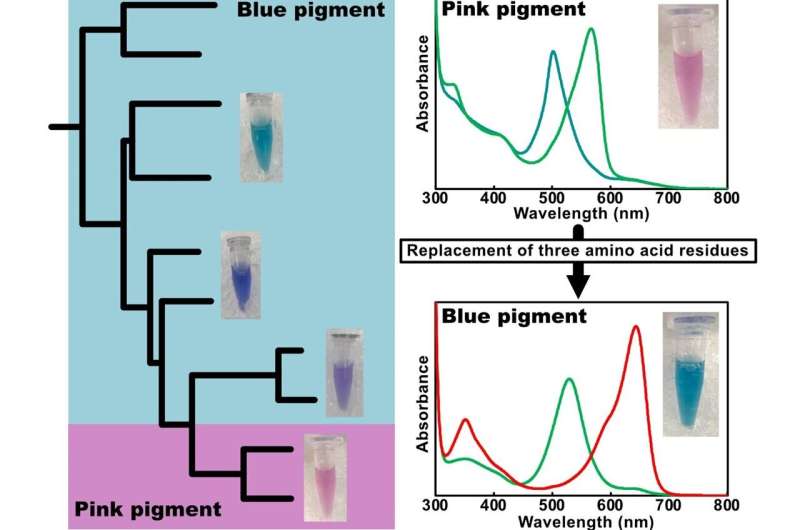
Molecular plasticity of cyanobacteriochromes. (left) Scientists have discovered a new CBCR-binding PVB (pink) in a family of photoreceptors that normally bind PCB (blue). (right) The new CBCR-binding PVB (pink) can switch between two different absorbing states (two curves), making it sensitive to green and blue-green light (top). When three amino acid residues in the CBCR are changed, PVB is isomerized to PCB (blue), completely changing the nature of the absorbing states. Image credit: Tokyo Metropolitan University
Scientists at Tokyo Metropolitan University have discovered a new photoreceptor in cyanobacteria whose structure has been partially altered, making it sensitive to green-blue light. The photoreceptor belongs to a family that is normally sensitive to red-green light in the environment.
They identified the parts of the amino acid structure responsible for this behavior. By editing these parts, sensitivity to red and green light could be restored – a remarkable example of the power of molecular “plasticity.”
Cyanobacteria, also known as blue-green algae, play an extremely important role in shaping nature as we know it. They are the first organisms on Earth known to produce oxygen by using light to break down water molecules.
The same chemical process is a distant relative of photosynthesis in plants. The chemical apparatus that supports such processes in cyanobacteria is called cyanobacteriochromes (CBCRs), cyanobacteria-specific photoreceptors. These are amino acid-based constructs that make them sensitive not only to the amount but also the color of light in the environment, helping them adapt to convert energy as efficiently as possible.
But how exactly do cyanobacteria distinguish colors? In the case of CBCRs, they bind a chemical that contains a chemical group known as linear tetrapyrrole. There is a wide range of linear tetrapyrrole pigments, and their color response depends on the length of the cloud of “conjugated” electrons that run along it.
For example, phycocyanobilin (PCB), a blue pigment, is bound by a CBCR and helps it respond to red or green light, switching reversibly between two different absorption states depending on the ratio of red to green light in the environment.
In contrast, CBCR-binding phycoviolobilin (PVB), a pink pigment, reacts to violet or yellow light in a similar way. Interestingly, PCB and PVB are an “isomer pair” because they have the same chemical composition but double bonds at different positions, which drastically changes their color.
The way pigments bind to CBCRs depends remarkably on their specific structure, which is determined by their amino acid sequence. However, the way in which different pigment/CBCR pairs elicit a variety of responses to light is not yet fully understood.
Now a team of researchers led by Associate Professor Rei Narikawa of Tokyo Metropolitan University has discovered another piece of the puzzle: a new CBCR from the photoreceptor family that should be sensitive to red and green light. The article was published in the journal Protein Science.
Uniquely, this CBCR binds PVB, the pink pigment, and responds to green or blue-green light. Given the differences from normal PVB-binding CBCRs, the team concluded that the pigment was bound to the CBCR in a new, different way.
By carefully analyzing the structure, they also identified three key amino acid residues that they believed were crucial for this unusual reaction. Once modified, the newly engineered CBCR was able to coax the PVB to turn back into PCB (the blue pigment), restoring sensitivity to red and green light.
The work highlights the remarkable diversity and “plasticity” of CBCRs, the ability to be shaped or changed, and advances our understanding of how cyanobacteria can “see” the world in color.
Further information:
Hiroki Hoshino et al., Red/green cyanobacteriochromes acquire isomerization of phycocyanobilin to phycoviolobilin, Protein Science (2024). DOI: 10.1002/pro.5132
Provided by Tokyo Metropolitan University
Quote: Novel photoreceptor sheds light on how cyanobacteria “see” colors (August 19, 2024), accessed August 19, 2024 from https://phys.org/news/2024-08-photoreceptor-cyanobacteria.html
This document is subject to copyright. Except for the purposes of private study or research, no part of it may be reproduced without written permission. The contents are for information purposes only.

